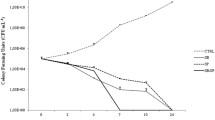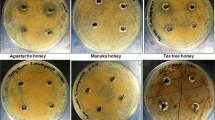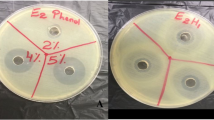Abstract
Stingless bee honey is an important component of African ethno-medicine, used to treat a variety of health conditions. However, there is scanty information on the therapeutic properties of honeys produced by Afrotropical stingless bees. This study investigated the antimicrobial properties of honeys produced by six species of stingless bees from different vegetation zones of Tanzania. Antimicrobial activity was assessed against standard cultures of Staphylococcus aureus, Bacillus subtilis, Salmonella typhi and Candida albicans by agar well diffusion and broth microdilution methods. Mean inhibition zones ranged from 7.0 – 26.3 mm for gram-positive bacteria, 6.9 – 26.9 mm for gram-negative bacteria and 17.0 – 30.9 mm for Fungi. On the other hand, geometric means of the minimum inhibitory concentrations ranged from 0.1 – 10% v/v for gram-positive bacteria, 0.1 – 20% v/v for gram-negative bacteria and 0.1 – 1.3% v/v for Fungi. Some honey samples exhibited stronger antibacterial activity compared to the standard antibiotic, ciprofloxacin (25 µg/mL). C. albicans displayed the highest sensitivity to stingless bee honey despite being resistant to fluconazole and terbinafine (25 µg/mL). The strongest antimicrobial effect was exhibited by honey samples produced by Dactylurina schmidti. Antimicrobial activity of stingless bee honey was largely influenced by the amount of phytochemicals. To the best of our knowledge, this is the first study that investigates antimicrobial activity of honeys produced by a number of Afrotropical stingless bee species. Our findings validate the use of stingless bee honey in traditional medicine and advocate for its potential for clinical management of complex wounds, candidiasis and drug resistant pathogenic microorganisms.









Similar content being viewed by others
Data availability
Data will be made available on request.
Change history
19 October 2023
A Correction to this paper has been published: https://doi.org/10.1007/s42690-023-01096-2
References
Abd Jalil MA, Kasmuri AR, Hadi H (2017) Stingless bee honey, the natural wound healer: a review. Skin Pharmacol Physiol 30(2):66–75. https://doi.org/10.1159/000458416
Afrin S, Haneefa SM, Fernandez-Cabezudo MJ, Giampieri F, Al-Ramadi BK, Battino M (2020) Therapeutic and preventive properties of honey and its bioactive compounds in cancer: an evidence-based review. Nutr Res Rev 33(1):50–76. https://doi.org/10.1017/S0954422419000192
Al-Kafaween MA, Alwahsh M, Mohd Hilmi AB, Abulebdah DH (2023) Physicochemical characteristics and bioactive compounds of different types of honey and their biological and therapeutic properties: a comprehensive review. Antibiotics 12(2):337. https://doi.org/10.3390/antibiotics12020337
Almasaudi S (2021) The antibacterial activities of honey. Saudi J Biol Sci 28(4):2188–2196. https://doi.org/10.1016/j.sjbs.2020.10.017
Alvarez-Suarez JM, Gasparrini M, Forbes-Hernández TY, Mazzoni L, Giampieri F (2014) The composition and biological activity of honey: a focus on Manuka honey. Foods 3(3):420–432. https://doi.org/10.3390/foods3030420
Andualem B (2013) Combined antibacterial activity of stingless bee (Apis mellipodae) honey and garlic (Allium sativum) extracts against standard and clinical pathogenic bacteria. Asian Pac J Trop Biomed 3(9):725–731. https://doi.org/10.1016/S2221-1691(13)60146-X
Ávila S, Hornung PS, Teixeira GL, Malunga LN, Apea-Bah FB, Beux MR, Beta T, Ribani RH (2019) Bioactive compounds and biological properties of Brazilian stingless bee honey have a strong relationship with the pollen floral origin. Food Res Int 123:1–10. https://doi.org/10.1016/j.foodres.2019.01.068
Becerril-Sánchez AL, Quintero-Salazar B, Dublán-García O, Escalona-Buendía HB (2021) Phenolic compounds in honey and their relationship with antioxidant activity, botanical origin, and color. Antioxidants 10(11):1700. https://doi.org/10.3390/antiox10111700
Boorn KL, Khor YY, Sweetman E, Tan F, Heard TA, Hammer KA (2010) Antimicrobial activity of honey from the stingless bee Trigona carbonaria determined by agar diffusion, agar dilution, broth microdilution and time-kill methodology. J Appl Microbiol 108(5):1534–1543. https://doi.org/10.1111/j.1365-2672.2009.04552.x
Brown E, O’Brien M, Georges K, Suepaul S (2020) Physical characteristics and antimicrobial properties of Apis mellifera, Frieseomelitta nigra and Melipona favosa bee honeys from apiaries in Trinidad and Tobago. BMC Complement Med Ther 20(1):1–9. https://doi.org/10.1186/s12906-020-2829-5
Chakuya J, Gandiwa E, Muboko N, Muposhi VK (2022) A review of habitat and distribution of common stingless bees and honeybees species in African savanna ecosystems. Trop Conserv Sci 15:19400829221099624. https://doi.org/10.1177/19400829221099623
Chanchao C (2009) Antimicrobial activity by Trigona laeviceps (stingless bee) honey from Thailand. Pak J Med Sci 25(3):364–369
Clinical and Laboratory Standards Institute (2015) Methods for dilution antimicrobial susceptibility tests for bacteria that grow aerobically; appproved standard, 11th edn. Wayne, PA, USA
Cortopassi-Laurino M, Imperatriz-Fonseca VL, Roubik DW, Dollin A, Heard T, Aguilar I, Venturierig GC, Eardley C, Nogueira-Neto P (2006) Global meliponiculture: challenges and opportunities. Apidologie 37(2):275–292. https://doi.org/10.1051/apido:2006027
Cruz CBND, Pieri FA, Carvalho-Zilse GA, Orlandi PP, Nunes-Silva CG, Leomil L (2014) Antimicrobial activity of honeys from two stingless honeybee species and Apis mellifera (Hymenoptera: Apidae) against pathogenic microorganisms. Acta Amazon 44:287–290. https://doi.org/10.1590/S0044-59672014000200015
DeMera JH, Angert ER (2004) Comparison of the antimicrobial activity of honey produced by Tetragonisca angustula (Meliponinae) and Apis mellifera from different phytogeographic regions of Costa Rica. Apidologie 35(4):411–417. https://doi.org/10.1051/apido:2004033
Deng J, Liu R, Lu Q, Hao P, Xu A, Zhang J, Tan J (2018) Biochemical properties, antibacterial and cellular antioxidant activities of buckwheat honey in comparison to manuka honey. Food Chem 252:243–249. https://doi.org/10.1016/j.foodchem.2018.01.115
Domingos SCB, Clebis VH, Nakazato G, de Oliveira AG Jr, Kobayashi T, Peruquetti RC, Pereira CD, Santa Rosa MT, dos Santos Medeiros L (2021) Antibacterial activity of honeys from Amazonian stingless bees of Melipona spp. and its effects on bacterial cell morphology. J Sci Food Agric 101(5):2072–2077. https://doi.org/10.1002/jsfa.10828
Dżugan M, Grabek-Lejko D, Swacha S, Tomczyk M, Bednarska S, Kapusta I (2020) Physicochemical quality parameters, antibacterial properties and cellular antioxidant activity of Polish buckwheat honey. Food Biosci 34:100538. https://doi.org/10.1016/j.fbio.2020.100538
Estevinho L, Pereira AP, Moreira L, Dias LG, Pereira E (2008) Antioxidant and antimicrobial effects of phenolic compounds extracts of Northeast Portugal honey. Food Chem Toxicol 46(12):3774–3779. https://doi.org/10.1016/j.fct.2008.09.062
Ewnetu Y, Lemma W, Birhane N (2013) Antibacterial effects of Apis mellifera and stingless bees honeys on susceptible and resistant strains of Escherichia coli, Staphylococcus aureus and Klebsiella pneumoniae in Gondar, Northwest Ethiopia. BMC Complement Altern Med 13(1):1–7. https://doi.org/10.1186/1472-6882-13-269
Foley C, Foley L, Lobora A, De Luca D, Msuha M, Davenport TRB, Durant SM (2014) A field guide to larger mammals of Tanzania. Princeton University Press, New Jersey, pp 20–24. https://doi.org/10.1515/9781400852802.20
Founou RC, Founou LL, Essack SY (2017) Clinical and economic impact of antibiotic resistance in developing countries: a systematic review and meta-analysis. PloS one 12(12):e0189621. https://doi.org/10.1371/journal.pone.0189621
Guerzou M, Aouissi HA, Guerzou A, Burlakovs J, Doumandji S, Krauklis AE (2021) From the beehives: identification and comparison of physicochemical properties of Algerian honey. Resources 10(10):94. https://doi.org/10.3390/resources10100094
Gośliński M, Nowak D, Kłębukowska L (2020) Antioxidant properties and antimicrobial activity of manuka honey versus Polish honeys. J Food Sci Technol 57:1269–1277. https://doi.org/10.1007/s13197-019-04159-w
Hau-Yama NE, Magaña-Ortiz D, Oliva AI, Ortiz-Vázquez E (2020) Antifungal activity of honey from stingless bee Melipona beecheii against Candida albicans. J Apic Res 59(1):12–18. https://doi.org/10.1080/00218839.2019.1665247
Héger M, Noiset P, Nkoba K, Vereecken NJ (2023) Traditional Ecological Knowledge and non-food uses of stingless bee honey in Kenya’s last pocket of tropical rainforest. medRxiv 2023–04. https://doi.org/10.1101/2023.04.22.23288962
Hrncir M, Jarau S, Barth FG (2016) Stingless bees (Meliponini): senses and behavior. J Comp Physiol A 202:597–601. https://doi.org/10.1007/s00359-016-1117-9
International Honey Commission (2002) Harmonised methods of the international honey commission. Swiss Bee Research Centre, FAM, Liebefeld, Switzerland
Johnston M, McBride M, Dahiya D, Owusu-Apenten R, Nigam PS (2018) Antibacterial activity of Manuka honey and its components: an overview. AIMS Microbiol 4(4):655. https://doi.org/10.3934/microbiol.2018.4.655
Kiprono SJ, Mengich G, Kosgei J, Mutai C, Kimoloi S (2022) Ethnomedicinal uses of stingless bee honey among native communities of Baringo County. Kenya. Sci Afr 17:e01297. https://doi.org/10.1016/j.sciaf.2022.e01297
Kidane AA, Tegegne FM, Tack AJM (2021) Indigenous knowledge of ground-nesting stingless bees in southwestern Ethiopia. Int J Trop Insect Sci 41(4):2617–2626. https://doi.org/10.1007/s42690-021-00442-6
Koc AN, Silici S, Ercal BD, Kasap F, Hörmet-Öz HT, Mavus-Buldu H (2009) Antifungal activity of Turkish honey against Candida spp. and Trichosporon spp.: an in vitro evaluation. Sabouraudia 47(7):707–712. https://doi.org/10.3109/13693780802572554
Kumar Singh A, Cabral C, Kumar R, Ganguly R, Kumar Rana H, Gupta A, Lauro MA, Carbone C, Reis F, Pandey AK (2019) Beneficial effects of dietary polyphenols on gut microbiota and strategies to improve delivery efficiency. Nutrients 11(9):2216. https://doi.org/10.3390/nu11092216
Kwapong PK, Ilechie AA, Kusi R (2013) Comparative antibacterial activity of stingless bee honey and standard antibiotics against common eye pathogens. J Microbiol Biotech Res 3(1):162–168
Liu JR, Ye YL, Lin TY, Wang YW, Peng CC (2013) Effect of floral sources on the antioxidant, antimicrobial, and anti-inflammatory activities of honeys in Taiwan. Food Chem 139(1–4):938–943. https://doi.org/10.1016/j.foodchem.2013.02.015
Mandal MD, Mandal S (2011) Honey: its medicinal property and antibacterial activity. Asian Pac J Trop Biomed 1(2):154–160. https://doi.org/10.1016/S2221-1691(11)60016-6
Masad RJ, Haneefa SM, Mohamed YA, Al-Sbiei A, Bashir G, Fernandez-Cabezudo MJ, Al-Ramadi BK (2021) The immunomodulatory effects of honey and associated flavonoids in cancer. Nutrients 13(4):1269. https://doi.org/10.3390/nu13041269
McLoone P, Warnock M, Fyfe L (2016) Honey: A realistic antimicrobial for disorders of the skin. J Microbiol Immunol Infect 49(2):161–167. https://doi.org/10.1016/j.jmii.2015.01.009
Mduda CA, Hussein JM, Muruke MH (2023) Traditional knowledge and uses of stingless bees (Hymenoptera, Apidae, Meliponini) in Tanzania. Int J Trop Insect Sci 43:1071–1088. https://doi.org/10.1007/s42690-023-01018-2
Mercês MD, Peralta ED, Uetanabaro APT, Lucchese AM (2013) Antimicrobial activity of honey from five species of Brazilian stingless bees. Ciência Rural 43(4):672–675
Michener CD (2013) The meliponini. In: Vit P, Pedro SRM, Roubik D (eds) Pot-honey: a legacy of stingless bees, 1st edn. Springer, New York, pp 3–17. https://doi.org/10.1007/978-1-4614-4960-7_1
Mokaya HO, Nkoba K, Ndunda RM, Vereecken NJ (2022) Characterization of honeys produced by sympatric species of Afrotropical stingless bees (Hymenoptera, Meliponini). Food Chem 366:130597. https://doi.org/10.1016/j.foodchem.2021.130597
Muruke MH (2014) Assessment of antioxidant properties of honeys from Tanzania. J Biol Agric Healthc 4(27):22–32
Ng W, Ken KW, Kumar RV, Gunasagaran H, Chandramogan V, Lee YY (2014) In-vitro screening of Malaysian honey from different floral sources for antibacterial activity on human pathogenic bacteria. Afr J Tradit Complement Altern Med 11(2):315–318. https://doi.org/10.4314/ajtcam.v11i2.14
Nishio EK, Ribeiro JM, Oliveira AG, Andrade CGTJ, Proni EA, Kobayashi RKT, Nakazato G (2016) Antibacterial synergic effect of honey from two stingless bees: Scaptotrigona bipunctata Lepeletier, 1836, and S. postica Latreille, 1807. Sci Rep 6:21641. https://doi.org/10.1038/srep21641
Nweze JA, Okafor JI, Nweze EI, Nweze JE (2016) Comparison of antimicrobial potential of honey samples from Apis mellifera and two stingless bees from Nsukka, Nigeria. J Pharmacogn Nat Prod 2(4):1–7. https://doi.org/10.4172/2472-0992.1000124
Pimentel RBDQ, da Costa CA, Albuquerque PM, Junior SD (2013) Antimicrobial activity and rutin identification of honey produced by the stingless bee Melipona compressipes manaosensis and commercial honey. BMC Complement Altern Med 13(1):1–14. https://doi.org/10.1186/1472-6882-13-151
Rane HS, Hayek SR, Frye JE, Abeyta EL, Bernardo SM, Parra KJ, Lee SA (2019) Candida albicans Pma1p contributes to growth, pH homeostasis, and hyphal formation. Front Microbiol 10:1012. https://doi.org/10.3389/fmicb.2019.01012
Rangkadilok N, Tongchusak S, Boonhok R, Chaiyaroj SC, Junyaprasert VB, Buajeeb W, Akanimanee J, Raksasuk T, Suddhasthira T, Satayavivad J (2012) In vitro antifungal activities of longan (Dimocarpus longan Lour.) seed extract. Fitoterapia 83(3):545–553. https://doi.org/10.1016/j.fitote.2011.12.023
Rao PV, Krishnan KT, Salleh N, Gan SH (2016) Biological and therapeutic effects of honey produced by honey bees and stingless bees: a comparative review. Rev Bras 26:657–664. https://doi.org/10.1016/j.bjp.2016.01.012
Rosli FN, Hazemi MHF, Akbar MA, Basir S, Kassim H, Bunawan H (2020) Stingless bee honey: Evaluating its antibacterial activity and bacterial diversity. Insects 11(8):500. https://doi.org/10.3390/insects11080500
Roubik DW (2006) Stingless bee nesting biology. Apidologie 37(2):124–143. https://doi.org/10.1051/apido:2006026
Shanahan M, Spivak M (2021) Resin use by stingless bees: a review. Insects 12(8):719. https://doi.org/10.3390/insects12080719
Shehu A, Ismail S, Rohin MAK, Harun A, Abd Aziz A, Haque M (2016) Antifungal properties of Malaysian Tualang honey and stingless bee propolis against Candida albicans and Cryptococcus neoformans. J Appl Pharm Sci 6(2):044–050. https://doi.org/10.7324/JAPS.2016.60206
Silva B, Biluca FC, Gonzaga LV, Fett R, Dalmarco EM, Caon T, Costa ACO (2021) In vitro anti-inflammatory properties of honey flavonoids: a review. Food Res Int 141:110086. https://doi.org/10.1016/j.foodres.2020.110086
Simoes M, Bennett RN, Rosa EA (2009) Understanding antimicrobial activities of phytochemicals against multidrug resistant bacteria and biofilms. Nat Prod Rep 26(6):746–757. https://doi.org/10.1039/B821648G
Singleton VL, Orthofer R, Lamuela-Raventós RM (1999) Analysis of total phenols and other oxidation substrates and antioxidants by means of folin-ciocalteu reagent. In: Packer L (ed) Methods in enzymology, vol 299. Academic Press, Massachusetts, pp 152–178. https://doi.org/10.1016/S0076-6879(99)99017-1
Suntiparapop K, Prapaipong P, Chantawannakul P (2012) Chemical and biological properties of honey from Thai stingless bee (Tetragonula leaviceps). J Apic Res 51(1):45–52. https://doi.org/10.3896/IBRA.1.51.1.06
Tanuwidjaja I, Svečnjak L, Gugić D, Levanić M, Jurić S, Vinceković M, Mrkonjić Fuka M (2021) Chemical profiling and antimicrobial properties of honey bee (Apis mellifera L.) venom. Molecules 26(10):3049. https://doi.org/10.3390/molecules26103049
Temaru E, Shimura S, Amano K, Karasawa T (2007) Antibacterial activity of honey from stingless honeybees (Hymenoptera; Apidae; Meliponinae). Pol J Microbiol 56(4):281–285
Tuksitha L, Chen YLS, Chen YL, Wong KY, Peng CC (2018) Antioxidant and antibacterial capacity of stingless bee honey from Borneo (Sarawak). J Asia Pac Entomol 21(2):563–570. https://doi.org/10.1016/j.aspen.2018.03.007
Vit P, Medina M, Eunice Enríquez M (2004) Quality standards for medicinal uses of Meliponinae honey in Guatemala, Mexico and Venezuela. Bee World 85(1):2–5. https://doi.org/10.1080/0005772X.2004.11099603
Vit P, van der Meulen J, Diaz M, Pedro SR, Esperança I, Zakaria R, Beckh G, Maza F, Meccia G, Engel MS (2023) Impact of genus (Geotrigona, Melipona, Scaptotrigona) in the targeted 1H-NMR organic profile, and authenticity test by interphase emulsion of honey processed in cerumen pots by stingless bees in Ecuador. Curr Res Food Sci 6:100386. https://doi.org/10.1016/j.crfs.2022.11.005
Zainol MI, Mohd Yusoff K, Mohd Yusof MY (2013) Antibacterial activity of selected Malaysian honey. BMC Complement Altern Med 13(1):1–10. https://doi.org/10.1186/1472-6882-13-129
Zamora G, Beukelman K, van den Berg B, Arias ML, Umaña E, Aguilar I, Sánchez LA, Fallas N, van Ufford LQ, Gross N (2014) The antimicrobial activity and microbiological safety of stingless bee honeys from Costa Rica. J Apic Res 53(5):503–513. https://doi.org/10.3896/IBRA.1.53.5.04
Zhishen J, Mengcheng T, Jianming W (1999) The determination of flavonoid contents in mulberry and their scavenging effects on superoxide radicals. Food Chem 64(4):555–559. https://doi.org/10.1016/S0308-8146(98)00102-2
Zulkhairi Amin FA, Sabri S, Mohammad SM, Ismail M, Chan KW, Ismail N, Norhaizan ME, Zawawi N (2018) Therapeutic properties of stingless bee honey in comparison with European bee honey. Adv Pharmacol Pharm Sci 2018:6179596. https://doi.org/10.1155/2018/6179596
Acknowledgements
The authors would like to thank the University of Dar es Salaam for funding the research and the Tanzania Forest Services Agency (TFS) for providing permits for the study and valuable assistance during sample collection.
Funding
This study was funded by the University of Dar es Salaam – Tanzania, under the academic staff development programme.
Author information
Authors and Affiliations
Corresponding author
Ethics declarations
Conflict of interest
Authors have no interests to disclose.
Additional information
Publisher's Note
Springer Nature remains neutral with regard to jurisdictional claims in published maps and institutional affiliations.
The original version of this article has been corrected to include the legend from Figure 3.
Rights and permissions
Springer Nature or its licensor (e.g. a society or other partner) holds exclusive rights to this article under a publishing agreement with the author(s) or other rightsholder(s); author self-archiving of the accepted manuscript version of this article is solely governed by the terms of such publishing agreement and applicable law.
About this article
Cite this article
Mduda, C.A., Muruke, M.H. & Hussein, J.M. Antimicrobial properties of honeys produced by stingless bees (Hymenoptera, Apidae, Meliponini) from different vegetation zones of Tanzania. Int J Trop Insect Sci 43, 1563–1581 (2023). https://doi.org/10.1007/s42690-023-01070-y
Received:
Accepted:
Published:
Issue Date:
DOI: https://doi.org/10.1007/s42690-023-01070-y




